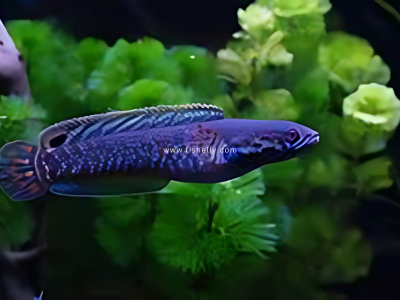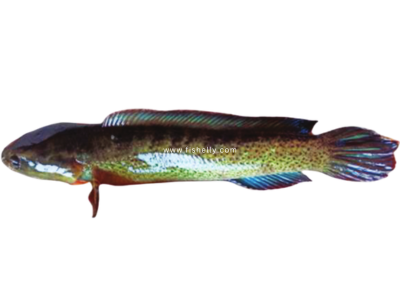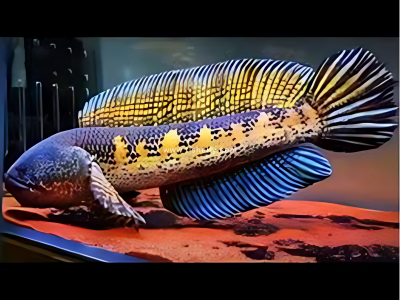Channa Fish Care Guide: Habitat, Diet, and Tank Setup
Learn how to care for Channa fish, including habitat, diet, and tank setup tips, to ensure they stay healthy and thrive in your aquarium.
Table of Contents
- What Are Channa Fish?
- Native Habitat
- How Many Species of Channa Fish Are There?
- How Do Channa Fish Survive?
- Breeding and Reproduction For Channa Fish
- How Do They Live in Groups?
- Maximum Size and Lifespan of Channa Fish
- Ideal Tank Setup for Channa Fish
- Diet and Food Habits For Channa Fish
- Diet and Food Habits For Channa Fish
- Male vs. Female Channa Fish
- What to Do and What Not to Do with Channa Fish
- Interesting Channa Fish Facts
- Faq
- Conclusion
Channa fish, or snakeheads, are interesting fish that have been capturing the attention of fish hobbyists around the world. With their interesting appearance, durability, and fascinating behaviors, they are considered one of the most interesting fish species in aquarium-keeping. Originally from Southeast Asia, Channa fish are durable and easy to care for, which make them perfect for expert and new aquarists alike. In this blog, we're going to look at all that you need to know about Channa fish, from where they live in nature to how you should care for them in your tank.

What Are Channa Fish?
Channa fish are a family of carnivorous freshwater fish native to Southeast Asia. They are commonly referred to as snakeheads due to their snake-like, elongated bodies and fighting spirit. They are highly resilient and can live in diverse freshwater habitats such as slow-moving rivers, lakes, swamps, and marshes. Their tolerance to low oxygen levels and their capacity to extract air from the surface enable them to survive in low-oxygen habitats.

Native Habitat
Channa fish are mostly found in India, Thailand, Sri Lanka, and Myanmar. They inhabit freshwater environments like rivers, ponds, and wetlands, where they prey on small fish, amphibians, and crustaceans. Channa fish are known to hide among thick vegetation and underwater caves, which provide protection from predators as well as make them ideal places to hunt.

How Many Species of Channa Fish Are There?
There are more than 30 known species of Channa fish, and they all have their own specific characteristics. Some of the most well-known species within the aquarium hobby include:
• Channa micropeltes (Giant Snakehead)

• Channa gachua (Dwarf Snakehead)

• Channa bleheri (Blue Snakehead)

They come in different sizes, colors, and temperaments, but they all have similar care requirements and survival mechanisms.
How Do Channa Fish Survive?
Channa fish are very resilient and are able to tolerate harsh environments. One of the most astonishing abilities of such fish is the power to withstand low-oxygen levels. The fish possess a special labyrinth organ which enables them to absorb oxygen from the atmosphere, so they are able to exist in an area with inadequate water quality and minimal oxygen availability. Secondly, Channa fish are opportunistic feeders, which means that they are capable of changing the food sources depending on what is available around them.
Breeding and Reproduction For Channa Fish
Channa fish are mouthbrooders, with the male holding the eggs after fertilization in his mouth until they hatch. The female produces the eggs, and the male keeps them away from harm by storing them in his mouth. After the eggs hatch, the male swallows the fry into the water where they start swimming free. This is a peculiar and interesting feature of Channa fish.
How Do They Live in Groups?
Even though Channa fish are usually solitary and can be territorial, they can coexist in groups if conditions are right. It should be noted that the fish are highly aggressive and can fight with one another, particularly the males. In an aquarium environment, having a single male per tank is advisable to prevent territorial conflicts. But with plenty of room and cover, Channa fish will get along harmoniously with other fish in a community tank.
Maximum Size and Lifespan of Channa Fish
Channa fish may range greatly in size according to species. The largest one, Channa micropeltes (Giant Snakehead), grows up to 3 feet (90 cm) in length. The smallest species, such as Channa gachua (Dwarf Snakehead), only reaches approximately 12 inches (30 cm) in length. In captivity, Channa fish are relatively long-lived and live up to 10 to 15 years when they are properly cared for. With good water quality, proper diet, and proper tank maintenance, they will live longer and healthier.
Ideal Tank Setup for Channa Fish
Channa fish need a large tank to survive. A tank capacity of not less than 30 gallons should be used for a single fish. The following are some of the important factors to note while creating a tank for Channa fish:
• Water Temperature: Maintain the water temperature at 75°F to 82°F (24°C to 28°C). Channa fish love warm water and will not survive in cold water.
• Water pH: Keep a pH range of 6.5 to 7.5 since Channa fish like slightly acidic to neutral water.
• Tank Decoration: Add many hiding places, like rocks, caves, and plants. Channa fish enjoy hiding and will feel safer with somewhere to hide.
• Filtration: Proper filtration should be maintained to prevent the water from getting dirty. Although Channa fish are able to live in low-oxygen conditions, healthy water is critical for them.
Diet and Food Habits For Channa Fish
Channa fish are carnivores and opportunistic feeders as they primarily feed on other fish, crustaceans, and amphibians. In captivity, they need to be fed high-protein foods. Below is a description of their diet habits:
• Favoured Foods: Channa fish like to live feed on food like smaller fish, shrimp, and earthworms. Frozen or freeze-dried foods can also be offered to them as convenient food by the aquarium keeper.

• Pellets and Flakes: Channa fish may also take pellets and flakes, but these should be complemented with higher-quality foods similar to their diet in nature.

• Feeding Frequency: Younger Channa fish should be fed daily, and adult Channa fish 2-3 times weekly. Ensure their diet is varied to provide them with all the necessary nutrients.
Male vs. Female Channa Fish
Male Channa Fish
• Size: Larger than females.
• Coloration: More vibrant, especially during breeding.
• Body Shape: Slimmer and elongated.
• Fins: Longer and more pointed dorsal and anal fins.
• Behavior: More aggressive and territorial, especially when guarding eggs.

Female Channa Fish
• Size: Smaller than males.
• Coloration: Duller and less vibrant.
• Body Shape: Rounder belly, especially when carrying eggs.
• Fins: Shorter and more rounded dorsal and anal fins.
• Behavior: Less aggressive and more passive than males.

What to Do and What Not to Do with Channa Fish
Below are some of the key dos and don'ts for caring for Channa fish:
What to Do:
• Give them a large tank with lots of hiding places.
• Keep the water clean and at a good temperature.
• Give them a diverse diet that includes live, frozen, and high-protein foods.
• Observe their behavior and keep them separated if they become too aggressive with each other.
What Not to Do:
• Do not pack the tank tightly, as Channa fish can become territorial and aggressive.
• Do not keep them with smaller, non-aggressive fish, which can be targeted as prey.
• Don't skip water changes and tank cleaning, as substandard water quality can cause health issues.
Interesting Channa Fish Facts
• Channa fish can "walk" on land with their pectoral fins. They can travel short distances over dry land to reach water or flee predators.
• They possess great hearing and can sense vibrations in the water, which assists them in finding prey.
• Channa fish are known for their aggressive nature, but they are also fascinating to watch as they display their hunting skills.

Faq
1. What are Channa fish?
Channa fish, also known as snakeheads, are carnivorous freshwater fish from Southeast Asia, known for their aggressive nature and ability to breathe air.
2. How big do Channa fish grow?
Sizes vary by species. The Giant Snakehead (Channa micropeltes) can reach 3 feet, while the Dwarf Snakehead (Channa gachua) grows up to 12 inches.
3. What is the lifespan of Channa fish?
With proper care, they can live 10–15 years in captivity.
4. What tank size is needed for Channa fish?
A minimum of 30 gallons is required for a single fish, with larger tanks needed for bigger species.
5. What water conditions do Channa fish need?
• Temperature: 75°F to 82°F (24°C to 28°C)
• pH: 6.5 to 7.5
• Filtration: Strong filtration is recommended, despite their ability to survive in low-oxygen water.
6. Are Channa fish aggressive?
Yes, they are highly territorial and aggressive, especially males. Keeping multiple males together is not advised.
7. What do Channa fish eat?
They are carnivores and prefer live food like small fish, shrimp, and earthworms, but can also eat frozen food and high-protein pellets.
8. Can Channa fish be kept with other fish?
Not recommended, as they tend to prey on smaller, non-aggressive fish.
9. How do Channa fish breed?
They are mouthbrooders; the male carries fertilized eggs in his mouth until they hatch.
10. Do Channa fish need hiding spots?
Yes, they prefer caves, plants, and rocks to hide and feel secure.
11. Can Channa fish survive out of water?
Yes, they have a special organ that allows them to breathe air and even "walk" on land for short distances.
12. What should I avoid when keeping Channa fish?
• Avoid overcrowding the tank.
• Do not keep them with small, peaceful fish.
• Don't neglect water quality and tank maintenance.
13. Are Channa fish legal to keep?
Laws vary by country; check local regulations before purchasing.
Conclusion
Channa fish are indeed fascinating creatures, providing an interesting challenge and thrill for fish tank hobbyists. With their beautiful appearance, hardy physiology, and intriguing behaviors, they can be an eye-catching member of any aquatic tank. If you know how to provide a proper environment that mimics their natural habitat, their dietary needs, and requirements for the aquarium, you can keep these marvelous fish as happy companions for a long time to come.
Have questions? Drop a comment below! #fishelly_official Fish Community






